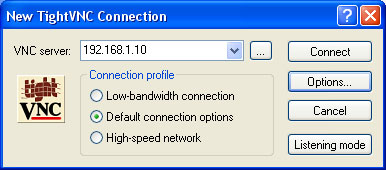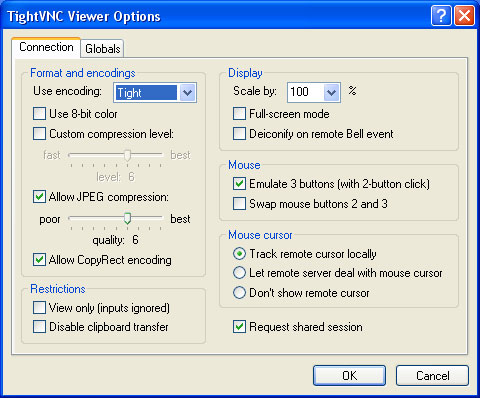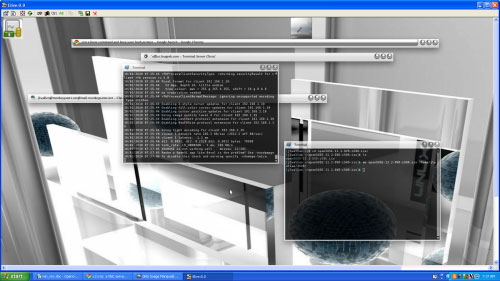Run remote Linux workstation in Windows
You may think that this is a rather complicated issue, but we are confident that after reading through this tutorial, everything will be simple for you. However, you may first ask yourself 'Why do I need this?'. This is a matter of governance. How many times have you had to run back and forth, waste time and waste a lot of time to solve a problem on computers. In the previous post, we showed you how to remotely connect to Windows 7 workstation from Linux, and in this article, with instructions on how to run the Linux workstation in Windows, we are sure that you will have it Everything needed to administer from a central location is easier.
Assumptions
First we will assume that both Windows and Linux workstations are working well and that both are connected on the same LAN. For simplicity, we will use the IP address 192.168.1.x. And obviously it will be easier (in this case), the IP addresses will be static addresses (otherwise you will have to find the IP address for your workstations).
Software used
Only two software need to be used:
- x11vnc: Installed on a Linux computer for use as a VNC server.
- TightVNC: Installed on a Windows computer for use as a VNC client
The installation of Windows software takes place quite simply. You just need to download the installer and double click on them. However for many Windows users, installing Linux software may not be so easy.
Obviously, Linux installation will depend on what your distribution is. But basically, all you need to do is follow these steps:
- Open Add / Remove Software tools (such as ynaptic, Ubuntu Software Center, gnome-packagekit, .).
- Search for 'x11vnc ' (without quotes).
- Select the installation result.
- Click Apply to install.
If you are more comfortable with the command line, you can install Linux software as follows:
- Open a terminal window
- Type in the command line command sudo apt-get install x11vnc (this command will depend on the distribution you use).
When all software is installed, go to the next step.
Linux side
On the Linux side is quite easy. All you need to do is launch the x11vnc server. If you look at the instructions page for x11vnc (issue man x11vnc command) you will see some options for the server. One of the options that you should consider is -forever . If you do not add this option to the command, your x11vnc server will " die " as soon as the client exits the session.
So the command you need to run from the terminal is:
x11vnc -forever
You will not see the prompt again, even if you add the & character , x11vnc will not return a prompt to you. Because of this problem, you should add a line like x11vnc -forever to the end of your /etc/rc.local file. This will ensure your x11vnc server will run at startup.
Windows side
This is the time of connection. You have installed TightVNC on your Windows machine, so go to the Start menu and launch TightVNC. You will now see a small window (as shown in Figure A), which allows you to enter the connection address as well as enable the Options window.
Figure A: Select the Connection Profile that best suits your connection type
In the Options window (Figure B), there are several items you need to configure. Unless you need a configuration, leave the default options.
Figure B: You can set TightVNC in View mode, which is an effective mode to connect the client to a non-interactive session.Good for training purposes.
After completing the configuration step, click the Connect button and the connection will be executed (Figure C). The speed of TightVNC will run depending on your network speed.
Figure C: Select options and create a connection
Conclude
You should read it
- 6 best Linux distributions for Windows users
- 5 reasons why Linux distros create their own desktop environment
- What is Unix / Linux?
- 28 interesting facts about Linux
- Learn about Linux MATE desktop environment
- How to Install Debian
- How to check the desktop environment you are using on Linux
- 5 ways to make Linux desktops look great
May be interested
- How to mount remote directory in Linux with SSHFS
 from an end-user perspective, sshfs is a simple and very easy to use solution. sshfs is also extremely secure because it depends on the proven openssh server.
from an end-user perspective, sshfs is a simple and very easy to use solution. sshfs is also extremely secure because it depends on the proven openssh server. - How to manage remote Linux server using SSH
 managing the server is still a necessary and sometimes heavy task. fortunately, secure shell (ssh) is available - a network protocol that allows services to run on an unsecured network.
managing the server is still a necessary and sometimes heavy task. fortunately, secure shell (ssh) is available - a network protocol that allows services to run on an unsecured network. - Network communication utilities in Unix / Linux
 when you work in a distribution environment then you need to communicate with remote users and you also need access to remote unix devices.
when you work in a distribution environment then you need to communicate with remote users and you also need access to remote unix devices. - Remote workstation security in Windows Server 2008 R2
 in this article we will discuss some of the security mechanisms included in rds along with how to use group policy and configuration settings.
in this article we will discuss some of the security mechanisms included in rds along with how to use group policy and configuration settings. - Install Windows 10 in VMWare Workstation virtual machine for computer
 installing windows 10 in a vmware workstation virtual machine for computers helps users use win 10 right on windows 8.1 or lower operating systems. please follow the instructions for installing windows 10 in the vmware workstation virtual machine below.
installing windows 10 in a vmware workstation virtual machine for computers helps users use win 10 right on windows 8.1 or lower operating systems. please follow the instructions for installing windows 10 in the vmware workstation virtual machine below. - How to install and use TeamViewer on Linux
 teamviewer is a powerful tool that allows teams to collaborate and share their screens in real time. it is also extremely useful in remote technology support.
teamviewer is a powerful tool that allows teams to collaborate and share their screens in real time. it is also extremely useful in remote technology support. - How to fix VMware Workstation VMCIDevVMX error on Windows
 vmware workstation is really useful for running virtual machines, but having errors in it is never a pleasant experience. especially if you've invested a lot in the operating system you've created.
vmware workstation is really useful for running virtual machines, but having errors in it is never a pleasant experience. especially if you've invested a lot in the operating system you've created. - 5 ways to control Linux computer from phone
 let's explore some linux tools that bridge the gap between your linux computer and your mobile phone!
let's explore some linux tools that bridge the gap between your linux computer and your mobile phone! - What is the difference between a workstation and a gaming PC?
 how exactly is a workstation pc different from a gaming pc? besides the rbg lights, are there any significant differences? can a gaming pc be used as a workstation without any problems?
how exactly is a workstation pc different from a gaming pc? besides the rbg lights, are there any significant differences? can a gaming pc be used as a workstation without any problems? - VMware Workstation Pro - Download VMware Workstation Pro here
 vmware workstation pro is a virtualization tool that allows users to run multiple operating systems on windows pcs. the platform creates a safe and isolated environment for users to create and test applications, test patches, and try out different operating systems before they go live.
vmware workstation pro is a virtualization tool that allows users to run multiple operating systems on windows pcs. the platform creates a safe and isolated environment for users to create and test applications, test patches, and try out different operating systems before they go live.













 Turn an old PC into a LAN Server with RouterOS - Part 1
Turn an old PC into a LAN Server with RouterOS - Part 1 Run Windows Server 2008 R2 - Install and create a Lab Domain Controller (Part 1)
Run Windows Server 2008 R2 - Install and create a Lab Domain Controller (Part 1) Turn an old PC into a LAN Server with RouterOS - Part 2
Turn an old PC into a LAN Server with RouterOS - Part 2 Instructions for using FreeRADIUS for Wi-Fi authentication - Part 1
Instructions for using FreeRADIUS for Wi-Fi authentication - Part 1 Instructions for using FreeRADIUS for Wi-Fi authentication - Part 2
Instructions for using FreeRADIUS for Wi-Fi authentication - Part 2 7 troubleshooting tips for Wireless N networks
7 troubleshooting tips for Wireless N networks